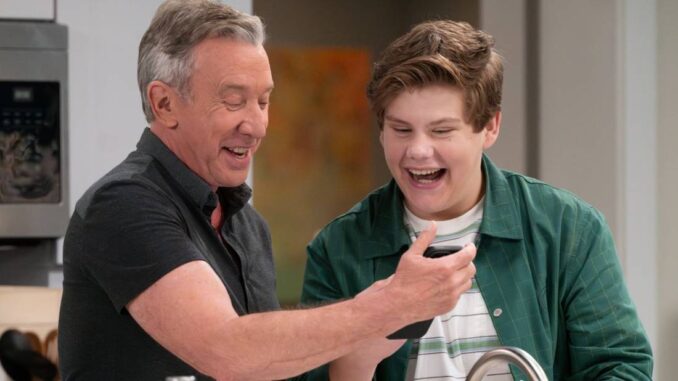
The Unseen Gears: The Truth Behind the Sudden Set Change in Tim Allen's Shifting Gears
The television landscape is a perpetually evolving ecosystem, a kaleidoscope of narratives, characters, and the meticulously crafted worlds they inhabit. Yet, few moments jolt an audience quite like the sudden, dramatic transformation of a beloved set. When Tim Allen’s fictional sitcom, Shifting Gears, unveiled its starkly modernized, almost unrecognizable primary set mid-season, the internet, as it often does, ignited. Theories abounded: budget cuts, creative differences, even a disgruntled prop master. But like a perfectly tuned engine humming beneath a polished hood, the true reasons behind such a significant shift are rarely singular or superficial. They are, instead, a complex interplay of creative evolution, production realities, and the very human impulse to keep moving forward.
For seasons, the primary setting of Shifting Gears had been Allen’s character’s workshop – a veritable temple of organized chaos. It was a space that whispered of sawdust, the faint scent of oil, and the reassuring clang of metal on metal. Every worn workbench, every pegboard laden with tools, every greasy rag draped just so, contributed to a tactile authenticity. This set wasn't merely a backdrop; it was a silent character, reflecting Allen’s persona as a hands-on, problem-solving everyman. It felt lived-in, comfortable, a visual shorthand for familiarity and tradition. For viewers, stepping into that workshop was like visiting an old friend, a comforting ritual in a rapidly changing world. The familiarity was its strength, but, as with any long-running ritual, it also became its eventual constraint.
The first, and perhaps most profound, gear shift driving the set change was creative necessity. Like a seasoned mechanic understanding that an engine needs more than just a new coat of paint to run optimally, the showrunners recognized that Shifting Gears needed an internal overhaul. Stories had broadened; characters had evolved. Allen’s character, initially a grounded, somewhat predictable archetype, had begun to explore new ventures, embrace different technologies, and grapple with a more interconnected world beyond the confines of his immediate garage. The old workshop, for all its charm, had become a narrative bottleneck. How could a character genuinely innovate or adapt to modern challenges when visually confined to a space that screamed "traditional" and "fixed"? The very walls, once comforting, began to feel like a cage, limiting the visual storytelling possibilities and, inadvertently, the emotional scope of the show.
This creative impetus was inextricably linked to the unseen, yet powerful, hum of production realities. Maintaining a detailed, highly tactile set like the original Shifting Gears workshop is an expensive and logistically challenging endeavor. Props wear out, dust accumulates, and the sheer volume of "stuff" requires constant care and organization. Moreover, as television production increasingly embraced digital integration and more fluid, adaptable staging, a static, intricate physical set could be seen as an anachronism. The new set, with its cleaner lines, modular components, and reliance on digital backdrops and projection mapping, offered unprecedented flexibility. It wasn't just about saving money, though efficiency is always a factor; it was about optimizing square footage, allowing for quicker scene changes, and providing a canvas that could be instantly reconfigured to represent multiple locations or moods. This shift represented a pragmatic, almost industrial, approach to creative problem-solving – something Tim Allen’s character would undoubtedly appreciate in his own work.
Finally, there was the subtle, often unspoken, influence of audience perception. In the age of binge-watching and constant content refreshment, even beloved shows can fall prey to a sense of visual stagnation. While familiarity is comforting, predictability can lead to disengagement. A drastic set change, while initially jarring, serves as a powerful visual declaration: "This show is not resting on its laurels. It's evolving. There's something new to see." It's a calculated gamble, a deliberate shake-up designed to reignite curiosity and demonstrate a commitment to keeping the visual narrative fresh, mirroring the thematic "shifting gears" of the show's title. It was an acknowledgment that even the most trusted tools in a craftsman's kit sometimes need an upgrade to remain relevant and effective.
The sudden set change in Tim Allen’s Shifting Gears was not a whimsical decision or a punitive measure. It was the inevitable culmination of creative ambition bumping against logistical practicalities, all under the watchful eye of an audience craving novelty. It was a bold statement that even the most grounded narratives must sometimes tear down their walls to build something new, more adaptable, and ultimately, more resonant. Like a master mechanic dismantling a classic engine to install a more powerful, efficient one, the showrunners understood that true progress sometimes demands a complete transformation, allowing the narrative to truly, and convincingly, shift into a higher gear.
